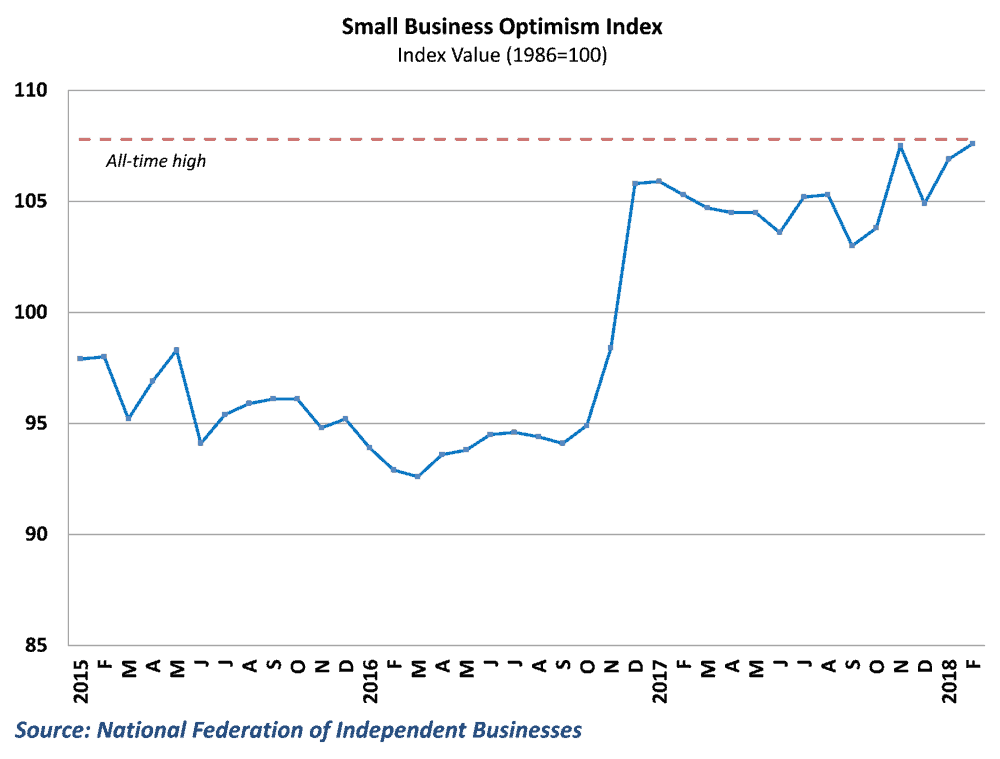Small businesses continue to feel encouraged by prospects in the US economy in the early months of 2018, and recent survey data suggests that this positive sentiment may soon translate into expanded business activity. The National Federation of Independent Businesses (NFIB) Small Business Optimism Index improved for the second consecutive month, rising to 107.6 in February. This marks the highest reading in over 13 years and nears the all-time high of 107.8, set in the mid-80s. (Story continued below)

The details of this morning’s report were overflowing with positive news, as index components covering hiring intentions, wage increases, and credit conditions all showed improvement during the month. The percentage of businesses reporting capital outlays rose to 66 percent, up 5 percent from January’s results and the highest reading since 2004.
The data on job creation and capital spending fall in line with last month’s results showing that firms believe that now is a good time to expand operation. It also serves as a sign that the recent enthusiasm about economic prospects is beginning to translate into actual economic activity. NFIB Chief Economist Bill Dunkelberg points out, ““Small business owners are telling us loud and clear that they’re optimistic, ready to hire, and prepared to raise wages – it’s one of the strongest readings I’ve seen in the 45-year history of the Index.” This transition from sentiment to actual activity is critical, as it is the actual activity that drives movements of goods and expansion of services in the economy.
Recent changes in tax and regulatory policy are likely behind some of the recent increases in optimism among small businesses. Indeed, President Trump’s promises of less taxes and reduced regulation helped fuel the surge in optimism immediately following his election in November 2016. For the first time since 2006, taxes received the fewest number of votes as the number one problem facing businesses in February’s results.
Overall this is a very encouraging report on the small business front, and yet another sign that the expansion in the economy is broadening to include small businesses. NFIB President and CEO Juanita Duggan comments: “The historically high readings indicate that policy changes – lower taxes and fewer regulations – are transformative for small businesses. After years of standing on the sidelines and not benefiting from the so-called recovery, Main Street is on fire again.”
Behind the Numbers:
The strong readings related to small business optimism are another in a series of indicators that show that sentiment in general is high in the economy. Survey data on small and large businesses, CEO sentiment, and consumer confidence have all pointed towards good feelings about the state of the economy.
However, despite the strong survey data, results on actual economy activity have not shown many signs of a real acceleration in growth. The economy grew 2.3% in 2017, which was a marked improvement from 2016, but roughly in line with the general trend since the recession. Current projections call for growth around 2.5% in the first quarter. Solid growth, to be sure, but this would be roughly in line with the growth experienced at the end of 2017.
As a result, there exists a bit of a disconnect between the optimism and the tangible, with some question of how exactly this disconnect gets resolved. Will optimism sink once consumers and business realize the actual economy is not meeting up to expectations, or will the economic activity begin to catch up to the sentiment? The readings from the NFIB this month point toward the latter, as businesses are signaling that they are beginning to expand operations, rather than just being satisfied with conditions.










